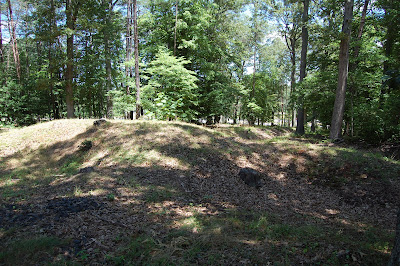About 6:30 on Friday evening, July 16, a freak storm took a powerful smack at downtown Fredericksburg, leaving many busted and uprooted trees, downed power lines, and damaged property in its wake. Weather forecasts had not predicted the event, and many visitors to the City were caught up in the tempest while attending a music festival along the Rappahanock River. The storm was over in less than half an hour. One woman was taken to the hospital for "a gash on her head, and another person was hit by a tent and treated for cuts by EMTs at the scene", according to the local newspaper, The Free-Lance Star.
On the other side of the City, to the west, a large tree uprooted in the Confederate Cemetery, tearing into the grave of Private Benjamin M. Blackwell, and busting numerous headstones. Blackwell had served in the 48th Virginia Infantry before being killed on May 5, 1864 in the battle of the Wilderness at the age of twenty-eight. The 1860 census shows he was a farmer, living with a relative who was a blacksmith. In the same record, Benjamin Blackwell claimed a value of $50 in personal property, not a rich man by any standard.
An interesting, and revealing article referencing Blackwell, in the journal "Civil War History", can be viewed here. A letter Blackwell wrote to his brother in late 1863, demonstrates his unease at the course of the war, and the Confederate nation's fate.
In September 2003, Hurricane Isabel left similar damage in the National Cemetery on Marye's Heights, tearing open the graves of two Union soldiers interred there.
The grave of Private Blackwell is seen here, burst open by the large tree.
A monument to to the Confederate dead is seen at center distance.
The ruptured grave is marked by a simple stone with the inscription,
B M Blackwell
VA
In amongst the branches of the fallen tree can be seen numerous other broken stones.
This view shows the overall size of the tree and the extent of the damage.
All photographs shown were taken approximately 24 hours after the storm, Saturday, July 17, 2010.
Copyright 2010, by John F. Cummings III
Images are clickable to allow for larger viewing.















